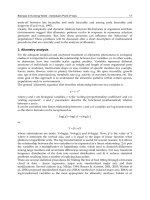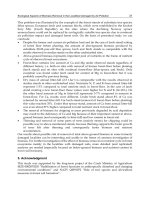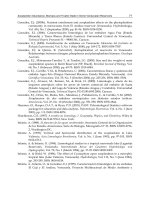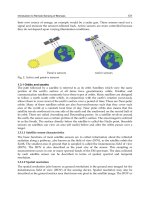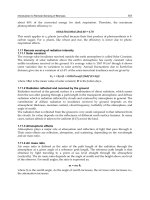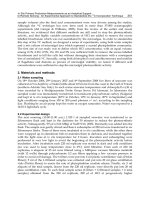Materials Science and Engineering - Electronic and Mechanical Properties of Materials Part 3 pot
Bạn đang xem bản rút gọn của tài liệu. Xem và tải ngay bản đầy đủ của tài liệu tại đây (271.07 KB, 10 trang )
3.225
15
• Compton, Planck, Einstein
– light (xrays) can be ‘particle-like’
• DeBroglie
– matter can act like it has a ‘wave-nature’
• Schrodinger, Born
– Unification of wave-particle duality, Schrodinger
Equation
Wave-particle Duality: Electrons are not just particles
© E. Fitzgerald-1999
3.225
16
Light is always quantized: Photoelectric effect (Einstein)
• Photoelectric effect shows that E=hν even outside the box
I,E,λ
e-
metal
block
Maximum
electron
energy,
E
max
ν
ν
c
E
max
=h(
ν
-
ν
c
)
!
For light with ν<ν
c
, no matter what the intensity, no e-
© E. Fitzgerald-1999
8
9
3.225
17
DeBroglie: Matter is Wave
• His PhD thesis!
• λ=h/p also for matter
• To verify, need very light matter (p small) so λ is large enough
• Need small periodic structure on scale of λ to see if wave is there (diffraction)
• Solution:electron diffraction from a crystal
Nλ=2dsinθ
For small
θ
,
θ
~
λ
/d, so
λ
must be on order of
d in order to measure easily
© E. Fitzgerald-1999
3.225
18
Ψ must be able to represent everything from a particle to a wave (the two
extremes)
Unification: Wave-particle Duality
wave
particle
(
tkxi
Ae
ω−
=Ψ
k and p known exactly
(
txki
n
n
nn
ea
ω−
∑
=Ψ
∞=
n
to create a delta function in ψ
2
generalized
(
txki
n
n
nn
ea
ω−
∑
=Ψ
© E. Fitzgerald-1999
)
)
)
3.225
19
Quantum Mechanics - Wave Equation
Classical Hamiltonian
QM Operators
EzyxV
m
p
=+
),,(
2
2
∆
=
i
p
h
ti
E
∂
∂
−=
h
1.
ψ
and
ψ∆
must be finite, continuous and single valued.
2.
*
ψψ
real with
dV
*
ψψ
= probability of finding particle in volume dV.
3. Average or expectation value of variable
∫
=
v
op
dV
ψαψα
*
ti
zyxV
m
∂
∂−
−=+∆−
ψ
ψψ
hh
),,(
2
2
2
© H.L. Tuller-2001
3.225
20
Time and Spatial Dependence of ψ
Assume ψ (x,y,z,t) separable into ψ(x,y,z) and φ(t)
Applying separation of variables:
ε
φ
φψ
ψ
=
∂
∂
−=+
∇−
ti
V
m
1
2
22
hh
= constant
Time-Dependent Equation:
()
(
titi
AeAet
ωε
φ
−−
==
h
ωε
h
=
Time-Independent Equation:
(
0
2
2
2
=−+∇ εψ
V
m
h
Solutions: ψ
n
-eigenfunctions; ε
n
-eigenvalues
⇒
© H.L. Tuller-2001
)
)
ψ
10
3.225
21
Free Particle
• One dimensional
OV
=
ψψ
εψ
2
22
2
2
k
m
dx
d
−=−=
h
ikx
Ae
=
ψ
)(
),(
tkxi
Aetx
ω
ψ
−
=
• Momentum
kdx
xi
p
x
h
h
=
∂
∂
=
∫
ψ
ψ
*
m
p
m
k
22
222
==
h
ε
kp
h=
Crystal Momentum
© H.L. Tuller-2001
3.225
22
Particle in Box
2
2
2
;
h
ε
ψ
m
kBeAe
ikxikx
=+=
−
Boundary Conditions:
0)()0(
==
d
ψψ
0)0(
=+=
BA
ψ
BA
−=⇒
0)()(
=−=
− ikdikd
eeAd
ψ
02
=⇒
ASinkd
d
n
k
π
=
3,2,1
=
n
=
d
xn
d
π
ψ sin
2
3,2,1=
n
V
0
=
x
dx =
∞
•
•
•
© H.L. Tuller-2001
∞
11
3.225
23
Particle in Box
zkykxkAzyx
n
321
sinsinsin),,(
⋅⋅=
ψ
2
3
2
2
2
1
2
kkkk
++=
;
d
n
k
i
i
π
=
3,2,1
=
i
n
m
k
nnn
md
n
2
)(
8
22
2
3
2
2
2
1
2
2
hh
=++=ε
n = Quantum numbers
• Degeneracy
First excited state 112, 211, 121
• Ground state E ;
1
321
===
nnn
not zero!
© H.L. Tuller-2001
3.225
24
Consequence of Electrons as Waves on Free Electron Model
Standing wave picture
Traveling wave picture
0
0
L
L
n
k
e
ee
Lxx
ikx
Lxikikx
π2
1
)()(
)(
=
=
=
+Ψ=Ψ
+
Just having a boundary condition means that k and E are quasi-continuous,
i.e. for large L, they appear continuous but are discrete
© E. Fitzgerald-1999
L
12
13
3.225
25
Representation of E,k for 1-D Material
m
p
m
k
E
22
222
==
h
E
k
∆k=2π/L
Quasi-continuous
k
m
k
E
m
k
dk
dE
∆=∆
=
2
2
h
h
states
electrons
E
n
E
n-1
E
n+1
m=+1/2,-1/2
All e- in box accounted for
E
F
k
F
k
F
Total number of electrons=N=2*2k
F
*L/2π
© E. Fitzgerald-1999
1
3.225
1
Representation of E,k for 1-D Material
2
1
2
221
)(
2
−
===
=
E
m
k
m
LdE
dk
dk
dN
Eg
Lk
N
F
hh ππ
π
g(E)=density of states=number of electron states per energy per length
•
n, the electron density, the number of electrons per unit
length is determined by the crystal structure and valence
•
n determines the energy and velocity of the highest
occupied electron state at T=0
2
or
22
2
π
ππ
n
k
mE
k
L
N
n
F
F
F
====
h
m
k
dk
dE
mE
k
m
k
E
2
22
2
;
2
h
h
h
=
==
© E. Fitzgerald-1999
3.225
2
Representation of E,k for 2-D Material
E(k
x
,k
y
)
k
x
k
y
m
kk
E
yx
2
)(
222
+
=
h
© E. Fitzgerald-1999
3.225
3
Representation of E,k for 3-D Material
k
x
k
y
k
z
Ε
(k
x
,k
y
,k
z
)
2
π
/L
m
kkk
E
zyx
2
)(
2222
++
=
h
Fermi Surface or Fermi Sphere
k
F
m
k
v
F
F
h
=
m
k
E
F
F
2
22
h
=
B
F
F
k
E
T
=
32
2
)(
h
mEm
Eg
π
=
(
3
1
2
3 nk
F
π=
© E. Fitzgerald-1999
)
3.225
4
So how have material properties changed?
• The Fermi velocity is much higher than
kT even at T=0! Pauli Exclusion raises
the energy of the electrons since only 2
e- allowed in each level
• Only electrons near Fermi surface can
interact, i.e. absorb energy and
contribute to properties
T
F
~10
4
K (T
room
~10
2
K),
E
F
~100E
class
, v
F
2
~100v
class
2
© E. Fitzgerald-1999
2
3
3.225
5
Effect of Temperature (T>0): Coupled electronic-thermal properties in conductors
• Electrons at the Fermi surface are able to increase energy: responsible for
properties
• Fermi-Dirac distribution
• NOT Bolltzmann distribution, in which any number of particles can occupy
each energy state/level
Originates from:
N possible configurations
T=0 T>0
E
F
1
1
)(
+
=
−
Tk
EE
b
F
e
f
If E-E
F
/k
b
T is
large (i.e. far from
E
F
) than
Tk
EE
b
F
ef
)(
−−
=
© E. Fitzgerald-1999
3.225
6
Fermi-Dirac Distribution: the Fermi Surface when T>0
µ~E
F
f(E)
1
T=0
T>0
0.5
k
b
T
k
b
T
E
All these e- not
perturbed by T
f
Boltz
Boltzmann-like tail, for
the larger E-E
F
values
v
v
T
U
c
∂
∂
=
Heat capacity of metal (which is ~ heat capacity of free e- in a metal):
(
[
( ( )
2
~~~ TkEgTkEgTkNEU
bFbFb
⋅⋅⋅∆⋅∆
U=total energy of
electrons in system
TkEg
T
U
c
bF
v
v
2
)(2
⋅⋅=
∂
∂
=
Right dependence, very close to exact derivation
© E. Fitzgerald-1999
)
]
)
3.225
7
Electrons in a Periodic Potential
• Rigorous path: HΨ=EΨ
• We already know effect: DeBroglie and electron diffraction
• Unit cells in crystal lattice are 10
-8
cm in size
• Electron waves in solid are λ=h/p~10
-8
cm in size
• Certain wavelengths of valence electrons will diffract!
© E. Fitzgerald-1999
3.225
8
Diffraction Picture of the Origin of Band Gaps
•
Start with 1-D crystal again
λ~a
a
1-D
θλ
sin2
dn
=
d=a,
sin
θ
=1
a
n
k
k
an
π
λ
π
λ
=
=
=
2
2
Take lowest order, n=1, and
consider an incident valence
electron moving to the right
x
a
i
oo
x
a
i
ii
e
a
k
e
a
k
π
π
ψ
π
ψ
π
−
=−=
==
;
;
Reflected wave to left:
Total wave for electrons with diffracted wavelengths:
x
a
i
x
a
oia
ois
oi
π
ψψψ
π
ψψψ
ψψψ
sin2
cos2
=−=
=+=
±=
a
kkk
oi
π
2
=−=∆
© E. Fitzgerald-1999
4

